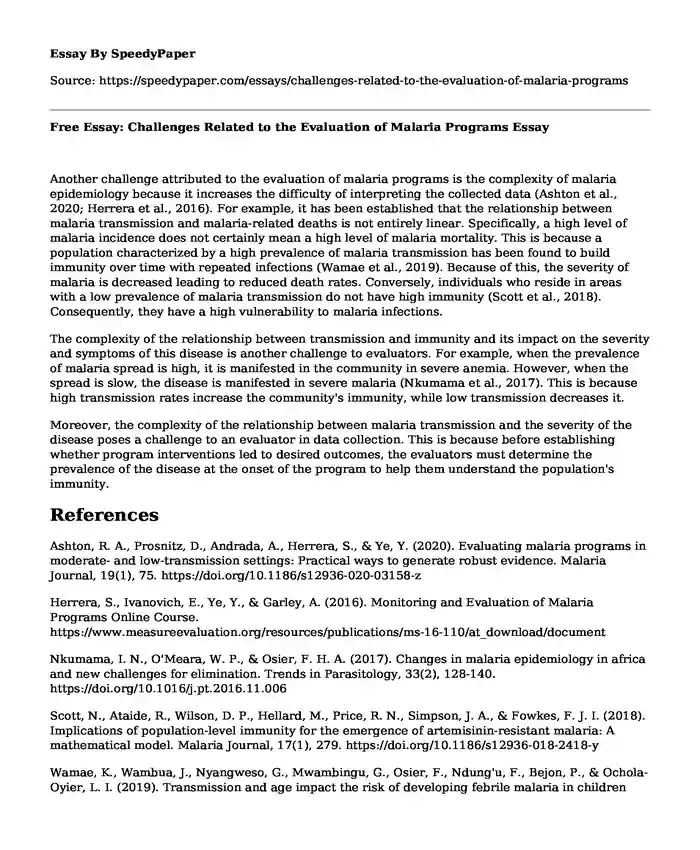
| Type of paper: | Essay |
| Categories: | Medicine Disorder Community health |
| Pages: | 2 |
| Wordcount: | 440 words |
Another challenge attributed to the evaluation of malaria programs is the complexity of malaria epidemiology because it increases the difficulty of interpreting the collected data (Ashton et al., 2020; Herrera et al., 2016). For example, it has been established that the relationship between malaria transmission and malaria-related deaths is not entirely linear. Specifically, a high level of malaria incidence does not certainly mean a high level of malaria mortality. This is because a population characterized by a high prevalence of malaria transmission has been found to build immunity over time with repeated infections (Wamae et al., 2019). Because of this, the severity of malaria is decreased leading to reduced death rates. Conversely, individuals who reside in areas with a low prevalence of malaria transmission do not have high immunity (Scott et al., 2018). Consequently, they have a high vulnerability to malaria infections.
The complexity of the relationship between transmission and immunity and its impact on the severity and symptoms of this disease is another challenge to evaluators. For example, when the prevalence of malaria spread is high, it is manifested in the community in severe anemia. However, when the spread is slow, the disease is manifested in severe malaria (Nkumama et al., 2017). This is because high transmission rates increase the community's immunity, while low transmission decreases it.
Moreover, the complexity of the relationship between malaria transmission and the severity of the disease poses a challenge to an evaluator in data collection. This is because before establishing whether program interventions led to desired outcomes, the evaluators must determine the prevalence of the disease at the onset of the program to help them understand the population's immunity.
References
Ashton, R. A., Prosnitz, D., Andrada, A., Herrera, S., & Ye, Y. (2020). Evaluating malaria programs in moderate- and low-transmission settings: Practical ways to generate robust evidence. Malaria Journal, 19(1), 75. https://doi.org/10.1186/s12936-020-03158-z
Herrera, S., Ivanovich, E., Ye, Y., & Garley, A. (2016). Monitoring and Evaluation of Malaria Programs Online Course. https://www.measureevaluation.org/resources/publications/ms-16-110/at_download/document
Nkumama, I. N., O'Meara, W. P., & Osier, F. H. A. (2017). Changes in malaria epidemiology in africa and new challenges for elimination. Trends in Parasitology, 33(2), 128-140. https://doi.org/10.1016/j.pt.2016.11.006
Scott, N., Ataide, R., Wilson, D. P., Hellard, M., Price, R. N., Simpson, J. A., & Fowkes, F. J. I. (2018). Implications of population-level immunity for the emergence of artemisinin-resistant malaria: A mathematical model. Malaria Journal, 17(1), 279. https://doi.org/10.1186/s12936-018-2418-y
Wamae, K., Wambua, J., Nyangweso, G., Mwambingu, G., Osier, F., Ndung'u, F., Bejon, P., & Ochola-Oyier, L. I. (2019). Transmission and age impact the risk of developing febrile malaria in children with asymptomatic plasmodium falciparum parasitemia. The Journal of Infectious Diseases, 219(6), 936-944. https://doi.org/10.1093/infdis/jiy591
Cite this page
Free Essay: Challenges Related to the Evaluation of Malaria Programs. (2023, Jul 09). Retrieved from https://speedypaper.com/essays/challenges-related-to-the-evaluation-of-malaria-programs
Request Removal
If you are the original author of this essay and no longer wish to have it published on the SpeedyPaper website, please click below to request its removal:
- Essay Example on Assessing the Competitiveness of StopNShop Today
- Critical Essay Sample on Grain Brain by David Perlmutter
- Free Essay on Omega-3 Fatty Acids: Which Is Best - Food or Fish Oils?
- Essay Example: PH Needs Assessments
- Proper Steps to a Healthy Heart - Free Paper Sample
- Free Essay Example on Addiction Recovery Care
- Navigating Genetic Factors and Cognitive Development Through the Lens of Piaget's Theory - Essay Sample
Popular categories




